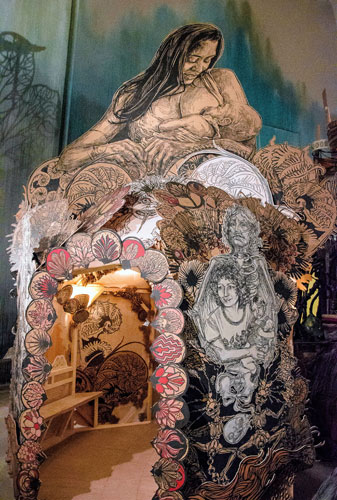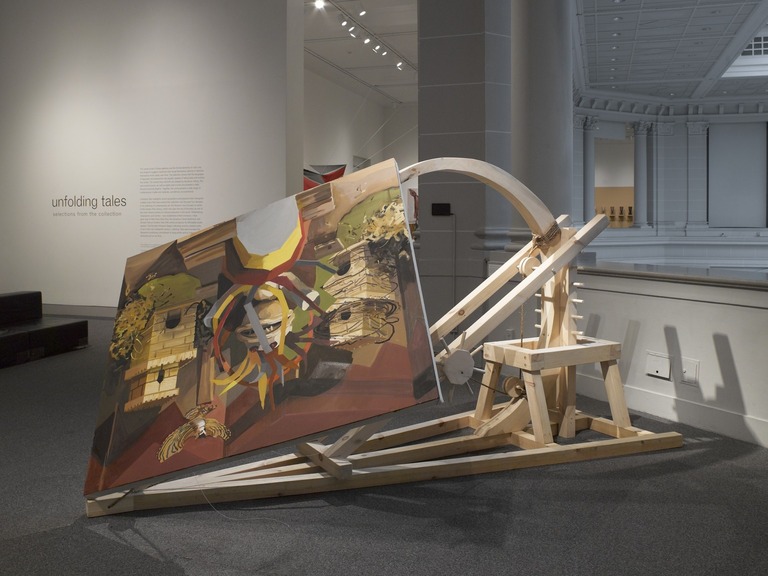Judy Chicago is a feminist artist best known for her piece called "The Dinner Party." This large art piece can be seen at the Elizabeth Sackler center of the Brooklyn Museum. Judy Chicago designed many individual place settings that are very beautifully designed. They are openly spread flowers with bold colors. The Dinner Party was a place where all women gathered. There are no place settings for men and most likely men wouldn't even want to be involved. The men believed that this art piece was pornographic and resembled women's private parts. This piece was a way to honor important women artists because many exhibitions would not show their work in their museums. Judy Chicago started a non-profit organization called Through the Flower in hopes to educate people on women's rights and how art essentially shapes us as a person. "I am trying to make art that relates to the deepest and most mythic concerns of human kind and I believe that, at this moment of history, feminism is humanism." (Chicago, n.p.)
 |
| Virginia Woolf place setting |
 |
| Dinner Party by Judy Chicago |
Valerie Hegarty is a contemporary artist who designed period rooms at the Brooklyn Museum. Her exhibit was called "Alternative Histories." Her themes included colonization and the Manifest Destiny. Her artwork was placed in the Cupola House and Hall as well as at the Plantation Dining Room. Her artwork reminds me of Judy Chicago's Dinner Party because it looks like an antique room. You could take Judy Chicago's place settings and put them in the dining room of Valerie Hegarty. They share a theme of rooms that you may have in your house. In the picture below the dining room actually looks a bit messy. It kind of looks like something was spilled on the table but even though it looks like a mess it is still really a nice piece. If you add in Judy's place settings you can have a really cool dining room table.
| Plantation Dining Room by Valerie Hegarty |
 |
| A chair made from fabrics |
The next artist is Swoon who is a Brooklyn Street artist. She continues her work today in NYC. Her exhibit at the Brooklyn Museum is also featured in the Elizabeth Sackler center. It is called "Submerged Motherlands." She focuses her artwork on social and environmental issues. Like some of the women artists we discussed in class she started her career with people thinking that she was a man. She put her art out on walls on the street and didn't care what others thought of her. She just wanted her art to be recognized. In the picture below Swoon has intricately designed feminist drawings combined into one large piece. If you look closely at the art piece you can see at least three pictures of women. The larger picture is of a mother breast feeding her newborn baby. Besdies the pictures of women you can see some flowers and nature like designs. This picture perfectly describes the two themes of social and the environment that Swoon bases her artwork on.
Lastly, Caitlin Cherry who is part of the Brooklyn Museum collection of "Raw Cooked" is known for her paintings of weapons. She was inspired by Leonardo Da Vinci's paintings of weapons. She is a contemporary artist who still continues her work to this day. Pictured below is Caitlin Cherry with her work displayed in the Brooklyn Museum. Her paintings are complex and kind of have that medieval times look to it. There's different shapes and weaponry throughout the painting. Both Swoon and Caitlin Cherry share a theme where they don't think gender matters. I say this because Swoon didn't care if people knew the identity of her gender and Caitlin Cherry was drawing themes related to history which used to be off limits for women to paint. As Judy Chicago said, "Ah, well I do wish we lived in a world where gender didn't figure so prominently? Of course. Do I even think about myself as a woman when I go to make art? Of course not." (Chicago, n.p.) This powerful quote shows that there are gender issues in art and that's something that these five women have all struggled with whether they have realized it or not.
 |
| Swoon's "Submerged Motherland" |
Lastly, Caitlin Cherry who is part of the Brooklyn Museum collection of "Raw Cooked" is known for her paintings of weapons. She was inspired by Leonardo Da Vinci's paintings of weapons. She is a contemporary artist who still continues her work to this day. Pictured below is Caitlin Cherry with her work displayed in the Brooklyn Museum. Her paintings are complex and kind of have that medieval times look to it. There's different shapes and weaponry throughout the painting. Both Swoon and Caitlin Cherry share a theme where they don't think gender matters. I say this because Swoon didn't care if people knew the identity of her gender and Caitlin Cherry was drawing themes related to history which used to be off limits for women to paint. As Judy Chicago said, "Ah, well I do wish we lived in a world where gender didn't figure so prominently? Of course. Do I even think about myself as a woman when I go to make art? Of course not." (Chicago, n.p.) This powerful quote shows that there are gender issues in art and that's something that these five women have all struggled with whether they have realized it or not.
 |
| Caitlin Cherry with her artwork |
 |
| Cherry's painting on a wooden structure |
In conclusion, Chicago, Hegarty, and Scott are feminist artists who share a theme of social and gender issues and they show this through art pieces that are like something you would find in your home. Swoon and Caitlin Cherry also show social issues related to their gender. You can argue that they all create art that would be common for women to do. Art pieces that relate to the home would be something common for women since they are the ones who decorate and take care of the home. Also, they are showing that they can do anything they want in life and that certain things aren't just a job for men.
Bibliography:
"Exhibitions: Raw/Cooked: Caitlin Cherry." Brooklyn Museum: Raw/Cooked: Caitlin Cherry. Web. 14 Apr. 2015. http://www.brooklynmuseum.org/exhibitions/raw_cooked_cherry/.
"Exhibitions: The Dinner Party by Judy Chicago." Brooklyn Museum: The Dinner Party by Judy Chicago. Web. 14 Apr. 2015. <https://www.brooklynmuseum.org/exhibitions/dinner_party/>.
"Exhibitions: Valerie Hegarty: Alternative Histories." Brooklyn Museum: Valerie Hegarty: Alternative Histories. Web. 14 Apr. 2015. <https://www.brooklynmuseum.org/exhibitions/valerie_hegarty/>.
"Exhibitions: Judith Scott-Bound and Unbound." Brooklyn Museum: Judith Scott-Bound and Unbound. Web. 14 Apr. 2015. <https://www.brooklynmuseum.org/exhibitions/judith_scott/>.
"Elizabeth A. Sackler Center for Feminist Art: Feminist Art Base: Swoon." Brooklyn Museum:. Web. 14 Apr. 2015. https://www.brooklynmuseum.org/eascfa/feminist_art_base/gallery/swoon.php.
Chicago, Judy. "Through the Flower and Judy Chicago." Through the Flower and Judy Chicago. Web. 15 Apr. 2015. <http://www.throughtheflower.org/>.

No comments:
Post a Comment